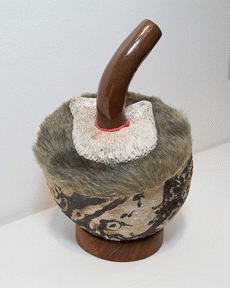In a bright, open space on Second Street and
Avenue B in Manhattan, an exhibition featuring twelve artists of Guyanese descent
is on view at the Wilmer Jennings Gallery.
Guyana is a country that is approximately the
same size as the state of Idaho. Although it is situated on the northern coast
of South America, it is considered part of the "Anglo-Caribbean." The Dutch,
French, and English all planted their imperial flags on the terrain. With the abolishment
of slavery in 1834, an influx of workers from East India came to the country.
Today, 50 percent of the population is descended from East Indians and 36
percent is of African descendent.
At the opening, I was able to speak with several
of the artists as well as the show's curator, Carl E. Hazlewood. His stated
goal was to inform a larger audience about the achievements of artists of
Guyanese ancestry.
Almost forty works of photography, painting,
welded steel, works on paper, and sculpture provided the foundation for
expression that covered a continuum from abstraction to political subtext.
The ceramic and mixed-media sculptures of
internationally recognized Donald Locke established
an anchor and point of reference. Three of his sculptures from 2008-2009 are
showcased on a wall shelf. They bear the titles: "Shaman's Rock," "The Legacy
of Hernando Cortez," and "Interlude for Ginny: Timehri Bottle." Employing
disparate elements including hair, fur, metal, and coral, they are combined
with painted ceramic bases that feature recognizable figurative imagery in a
black and white pictographic style.
Interlude for Ginny: Timehri Bottle
Donald Locke
Photo: Mark Lee Blackshear
Situated in the same room is an overview of pieces dating from 1987 to 2008 by Gregory A. Henry. They demonstrate his facility as a painter, printmaker, and sculptor. In our conversation Henry told me, "I try to create forms that have many layers, using symbols and objects from the cultural landscape of Guyana, incorporating all the things that make the universe work and that we need in our lives." Henry reflected upon the push/pull, positive/negative, and ebb/flow -- as well as the humor -- that are consistently present in his ouevre. Looking at his "Untitled" sculpture of wood, steel, and coconuts from 1987 and his oil stick on panel "Stuff" from 2005, it is evident that the shapes, construction, and elements are clearly linked.
Left: Stuff Right: Untitled
Gregory A. Henry
Photo: Jamaal M. Levine
Victor Davson
is also represented by disparate time frames. His two pigment on paper drawings
from 1996, "Limbo Anansi XX" and "XXVII" emerged from a suite
that he completed in three weeks. Davson spoke about the "formal values of
line, movement, and color" present in the drawings. He pointed out that his
installation, "Dub Factor" (2008), shared the same formal values through
"placement and paint." The "appropriated imagery" such as soul musicians and a
reproduction of a portion of the United States dollar bill, tap into disparate topics,
from American pop culture to the capitalistic structure of the national
economy.
The oil diptych, "The Wounded Canvas: Lotus in
Spring Time," by Bernadette
Persaud, at first glance seems to be primarily about color and the floral
lushness of a garden's beauty. A further examination reveals a bleeding bullet
hole in the lower right hand corner. Of Indo-Guyanese heritage, Persaud acknowledges
the unresolved societal tensions within Guyana.
Marlon
Forrester blends a muscular intellectuality with his creativity. He spoke
about his insights into the "Black male body in sports," and how a specific
"manhood formula" is targeted to young African-American males in the 12 to 18
year old bracket. Using the digit 23, the iconic number that is associated
Michael Jordan, in both "White Nights I" and "White Nights II"--Forrester delves
into the ramifications of how the sport is sold and how it "commodifies"
individuals, while creating an ethos of distorted values and misogyny. At the
center of "White Nights I" is an inserted image of the artist holding a
basketball in a Christ-like position. It is covered with a blood red wash. In
"White Knights II," the center photo imagery has player Kobe Bryant--who was
embroiled in a sexual assault case--collaged with a woman's torso. Placed
directly to the left of this work is the assemblage, "Black Basketball." On a
sculpture pedestal, a black-coated basketball sits with a heavily
paint-encrusted pair of sneakers connected by their tied laces. Ominous in
tone, it can be interpreted as a contemporary form of shackles and chain.
Left: Black Basketball Right: White Nights II
Marlon Forrester
Photo: Jamaal M. Levine
Keisha
Scarville also explores identity. Her "Passport Series" is comprised of
twelve individually framed pieces that use her father's first passport photo as
the focal point. She interacts with the snapshot to "meditate on" her
relationship with her father, and to "overcome an emotional distance" that has
existed. Analyzing the effects of immigration, shifting the balance of power in
the parent/child relationship, redefining gender roles, Scarville reconstructs
her personal history while assuaging her specific emotional needs.
Additionally, there are three archival black and
white digital prints by Scarville from her "Ghana, West Africa" series. They
capture what she terms, "closed landscapes." Scarville's depiction of a young
boy, partially obscured behind a rusting pole in a field of grass, brilliantly
compliments Dudley Charles'
drawing and collage, "Jacob's Ladder." The two monochromatic works riff off of
each other's similar structures. The various lights and darks, textures,
markings, and lines in Charles' engaging 83" x 80" work on paper contrasts the
handmade mark with the observations of the photographic eye.
Jacob's Ladder
Dudley Charles
Photo: Mark Lee Blackshear
Timehri Transitions: Expanding Concepts in Guyana Art Exhibiting Artists : damali abrams, Carl Anderson, Dudley Charles, Victor Davson, Marlon Forrester, Gregory A. Henry, Siddiq Khan, Donald Locke, Andrew Lyght, Bernadette Persaud, Keisha Scarville, Arlington Weithers









